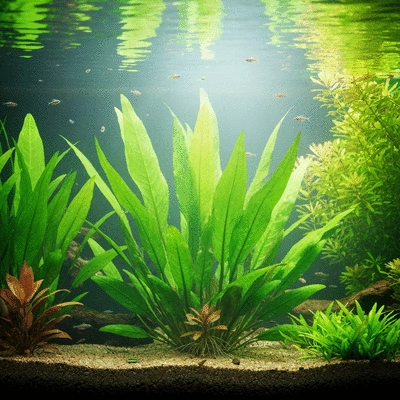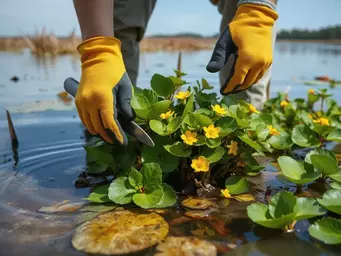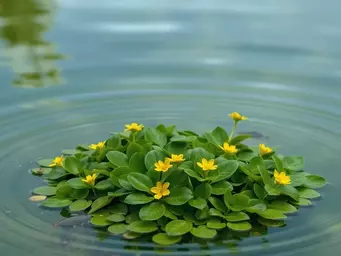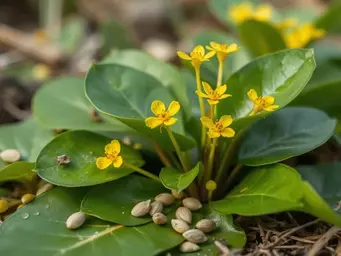![Genetic Diversity and Hybridization in Ludwigia peploides: Insights from Chromosome Studies[3][4]](https://ludwigiapeploides.com/img/zpPCPoLYsB-UL_IMAGEUz4Hla.webp)
Genetic Insights in Ludwigia peploides
What if understanding the genetic diversity of a plant species could hold the key to preserving entire ecosystems? Recent research reveals that the genetic traits of Ludwigia peploides, or creeping water primrose, significantly influence not just its survival but the health of its habitat. Let’s dive into the key insights you can gain about this fascinating aquatic plant.
What You Will Learn
- Genetic diversity enables Ludwigia peploides to adapt better to changing environmental conditions, enhancing its resilience against stressors like drought and salinity.
- The species plays a critical role in providing habitat for aquatic life while also contributing to nutrient cycling and water quality in ecosystems.
- Understanding the geographic distribution and genetic variation of Ludwigia peploides is essential for effective management strategies tailored to both native and invasive populations.
- Integrating genetic insights into conservation efforts can significantly improve restoration success and promote biodiversity in impacted habitats.
Genetic Insights for Ludwigia peploides Conservation
Understanding the genetic diversity and geographical distribution of Ludwigia peploides is crucial for effective conservation strategies. Below, we highlight key aspects of genetic variation and its practical applications.
Genetic Diversity: What it Influences
- ✓ Adaptation to new challenges
- ✓ Resilience against diseases/pests
- ✓ Ecosystem health & stability
Geographic Variation: Key Insights
- ● Native vs. Invasive Population Differences
- ● Local Adaptations to environments
- ● Conservation & Restoration Guidance
Conservation Strategies from Genetics
- ✓ Genetic diversity assessment
- ✓ Population health monitoring
- ✓ Habitat restoration efforts
Hybrid Vigor & Genetic Rescue
- ● Hybrid vigor: increased growth/resilience
- ● Genetic rescue: introducing new material
- ● Enhances long-term population viability
Understanding Genetic Diversity in Ludwigia peploides
As an ecologist, I've always found genetic diversity to be a fascinating aspect of plant ecology, especially when it comes to aquatic plants like Ludwigia peploides, or creeping water primrose. Understanding this diversity is essential for managing ecosystems effectively, particularly as invasive species like Ludwigia can radically change their surroundings. In this section, let’s unpack what genetic diversity means and why it matters for this species and its ecosystems.
Defining Genetic Diversity in Aquatic Plants
Genetic diversity refers to the variety of genes within a species, playing a critical role in how that species can adapt to changing environments. In aquatic plants, this diversity can influence everything from growth rates to resilience against diseases. For instance, a genetically diverse population of Ludwigia peploides can better withstand environmental stresses such as drought or increased salinity. For a deeper dive into how genetic diversity impacts adaptation and resilience, you can explore research on genetic diversity and hybridization in aquatic plants.
- Adaptation: Diverse genetic traits allow populations to adjust to new challenges.
- Resilience: Greater variability can protect against diseases and pests.
- Habitat Stability: Genetic diversity contributes to ecosystem health and stability.
Through my work at the Ludwigia Peploides Resource Center, I aim to highlight these aspects, providing tools and insights that help ecologists and land managers appreciate the importance of genetic diversity in aquatic ecosystems.
Importance of Ludwigia peploides in Ecosystems
Ludwigia peploides plays a vital role in many aquatic ecosystems. As it grows, it provides habitat for various fish and invertebrate species, supporting local biodiversity. However, its invasive nature poses challenges as it can choke waterways and outcompete native plants for resources. Understanding its role helps us manage these ecosystems better, as detailed in various environmental impact reports.

- Habitat Provision: Supports species that rely on aquatic plants for shelter.
- Nutrient Cycling: Contributes to the nutrient dynamics of aquatic habitats.
- Water Quality: Can influence the chemical makeup of water bodies.
In my experience, recognizing both the positive and negative impacts of Ludwigia peploides allows us to devise effective management strategies that balance ecological health with the needs of local communities.
Geographic Distribution and Genetic Variation in Ludwigia peploides
The geographic distribution of Ludwigia peploides spans many regions, from North America to parts of South America and Eurasia. This wide distribution leads to significant genetic variation within populations. Each population may exhibit unique adaptations to its specific environment, which is critical for their survival and management. For more insights into how geographical factors influence plant populations and their management, resources like the McDonald-Dunn Forest Plan offer valuable context on ecological planning.
- Native vs. Invasive Populations: Understanding differences helps tailor management efforts.
- Local Adaptations: Genetic variations can reveal how populations cope with local conditions.
- Conservation Routes: Knowledge of genetic structure aids in the restoration of native habitats.
As I delve deeper into the genetic research of this species, I see how critical these geographic and genetic insights are for the ongoing conservation efforts at the Ludwigia Peploides Resource Center. They empower land managers and ecologists to make informed decisions that promote biodiversity and ecological balance.
Pro Tip
When managing populations of Ludwigia peploides, consider implementing genetic rescue strategies. By introducing genetically diverse individuals from other populations, you can enhance the resilience of local groups and promote healthier ecosystems. This approach not only helps mitigate the invasive tendencies of Ludwigia but also supports the restoration of native species, ensuring a balanced habitat.
Practical Applications of Genetic Studies in Conservation
At the Ludwigia Peploides Resource Center, we understand that genetic studies play a critical role in shaping effective conservation strategies for aquatic ecosystems. By leveraging genetic insights, we can tailor our approaches to manage and restore habitats affected by invasive species like Ludwigia peploides. This not only helps in controlling the spread of this invasive plant but also aids in the conservation of native biodiversity.
Genetic assessments provide valuable data that can inform practical conservation actions. For instance, identifying genetically distinct populations can guide efforts to maintain genetic diversity, which is essential for the resilience of ecosystems. Have you ever considered how genetic variation can affect the survival of plant species in changing environments? Let's delve deeper into this topic!
Using Genetic Insights for Effective Conservation Strategies
Integrating genetic knowledge into conservation planning involves several important steps:
- Assessment of Genetic Diversity: Understanding the genetic variation within Ludwigia peploides populations helps identify which groups are more resilient to environmental changes.
- Monitoring Populations: Regular monitoring using genetic markers can track changes in population structure and health over time.
- Restoration Efforts: When restoring habitats, incorporating genetically diverse plant material can enhance the success of replanting initiatives.

By applying these strategies, we not only enhance the chances of success in our conservation efforts but also contribute to a healthier ecosystem overall.
Addressing Hybrid Vigor: Fitness Consequences in Natural Populations
Hybrid vigor, or heterosis, is an intriguing phenomenon where crossbred individuals often exhibit improved physical and reproductive traits. In the context of Ludwigia peploides, understanding hybrid vigor can have significant implications:
- Increased Growth Rates: Hybrids may grow faster and establish more quickly in disturbed habitats.
- Enhanced Resilience: These plants may be better adapted to varying environmental conditions, making them more likely to thrive.
- Potential for Invasive Spread: While hybrid vigor can be beneficial for conservation, it can also lead to increased invasiveness if not managed properly.
As we navigate the complexities of hybridization in natural populations, it’s crucial to weigh both the advantages and challenges presented by hybrid vigor.
Genetic Rescue and Its Role in Conservation Genetics
Genetic rescue is a fascinating concept that can rejuvenate struggling populations. It involves introducing individuals from genetically diverse populations to enhance the overall genetic health of a small or inbred group. Here are a few key points on how genetic rescue is applied:
- Improving Genetic Diversity: By introducing new genetic material, we can reduce the risks associated with inbreeding.
- Restoring Ecological Balance: Genetic rescue can help maintain populations of native species that are impacted by invasive species like Ludwigia peploides.
- Long-term Population Viability: Enhancing genetic diversity supports the long-term survival of populations under environmental stress.
Through genetic rescue initiatives, we can promote a more balanced ecosystem where native plants can thrive alongside their invasive counterparts.
Frequently Asked Questions (FAQs)
- Q1: Why is genetic diversity important for Ludwigia peploides?
- A1: Genetic diversity in Ludwigia peploides enables the species to adapt better to changing environmental conditions, increasing its resilience against stressors like drought, salinity, diseases, and pests. It also contributes to overall ecosystem health and stability.
- Q2: What is the role of Ludwigia peploides in aquatic ecosystems?
- A2: Ludwigia peploides provides habitat for various aquatic life, supports local biodiversity, contributes to nutrient cycling, and can influence water quality. However, its invasive nature can also lead to negative impacts by outcompeting native plants.
- Q3: How does geographic distribution affect the genetic variation of Ludwigia peploides?
- A3: The wide geographic distribution of Ludwigia peploides leads to significant genetic variation, with different populations developing unique adaptations to their specific local environments. Understanding these differences is crucial for tailored management and conservation efforts.
- Q4: How are genetic insights used in conservation strategies for Ludwigia peploides?
- A4: Genetic insights are used to assess genetic diversity, monitor population health over time, and guide restoration efforts. This helps identify resilient groups, track changes, and enhance the success of replanting initiatives with genetically diverse material.
- Q5: What is hybrid vigor and how does it relate to Ludwigia peploides?
- A5: Hybrid vigor (heterosis) refers to the phenomenon where crossbred individuals exhibit improved traits. In Ludwigia peploides, this can mean increased growth rates and enhanced resilience, which can be beneficial for survival but also contribute to its invasive spread if not managed properly.
- Q6: What is genetic rescue and why is it important in conservation?
- A6: Genetic rescue involves introducing individuals from genetically diverse populations into a struggling, inbred group to improve its overall genetic health. This is important for increasing genetic diversity, reducing inbreeding risks, and enhancing the long-term viability of populations, especially those impacted by invasive species.
Recap of Key Points
Here is a quick recap of the important points discussed in the article:
- Genetic Diversity: Vital for adaptation, resilience, and habitat stability in aquatic plants like Ludwigia peploides.
- Ecosystem Importance: Provides habitat and contributes to nutrient cycling and water quality in aquatic ecosystems.
- Geographic Variation: Genetic differences across regions inform effective management strategies for native and invasive populations.
- Conservation Strategies: Assessing genetic diversity and monitoring populations are key in tailoring conservation efforts.
- Hybrid Vigor: Can lead to increased growth rates and resilience but may also enhance invasiveness if not managed properly.
- Genetic Rescue: Introducing genetic diversity can improve the health and viability of struggling populations.

![Genetic Diversity and Hybridization in Ludwigia peploides: Insights from Chromosome Studies[3][4]](https://ludwigiapeploides.com/img/zpPCPoLYsB-UL_IMAGEUz4Hla-t.webp)



Genetic Insights in Ludwigia peploides
Manual Removal of Water Primrose
Ludwigia Peploides and Biodiversity Impact
Ludwigia Peploides Reproduction Explained
Ludwigia peploides Control Methods Explained